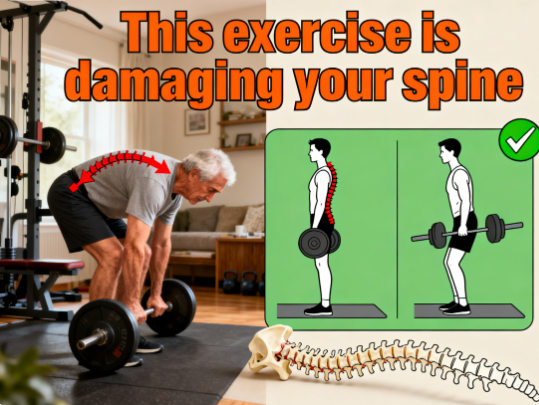
This Exercise Is Damaging Your Spine… See More
It’s a beautiful morning at the community park. You see them everywhere—people in their 50s, 60s, and beyond, bending forward at the waist, reaching for their toes, trying to touch the ground. Some are swinging their torsos vigorously from side to side. Others are lying on their backs, pulling their knees to their chest with determination. They believe they’re doing something healthy—”stretching out the kinks” and “staying flexible.” What they don’t realize is that they might be slowly damaging their spines with every repetition.
For decades, we’ve been taught that flexibility is the holy grail of fitness, especially as we age. But what if some of the most common exercises—the very ones taught in senior fitness classes and recommended by well-meaning trainers—are actually compromising spinal health? What if your quest for flexibility is putting you at risk for herniated discs, pinched nerves, and accelerated arthritis?
The truth is that not all movement is good movement—especially for aging spines that may already be experiencing natural degenerative changes.
The Worst Offenders: Exercises That Hurt More Than Help
- Toe Touches (Standing or Seated)
This classic stretch forces the spine into extreme flexion, putting excessive pressure on the front of the vertebral discs. For people with osteoporosis, this movement significantly increases the risk of vertebral compression fractures. Even for those with healthy bones, repeated forward bending can weaken disc integrity over time. - Sit-Ups and Crunches
Once the gold standard of core work, we now know these exercises generate tremendous compressive forces on the spine. A typical sit-up can put up to 730 pounds of pressure on the lumbar discs—more than enough to cause or exacerbate disc problems. - Double Leg Lifts
Lying on your back and raising both legs together might feel like great abdominal work, but it forces the spine into uncontrolled flexion and places enormous strain on the lower back. This exercise frequently triggers back spasms in middle-aged and older adults. - Deep Twists (Especially Under Load)
Rotating the spine while holding weight—whether in yoga class or at the gym—can overstress the spinal joints and discs. The older spine has less rotational mobility, and forcing rotation can lead to joint inflammation and disc injury. - Neck Circles
The cervical spine is particularly vulnerable as we age. Rolling the head in circles can compress nerves and arteries in the neck, potentially causing dizziness, nerve irritation, and even reduced blood flow to the brain.
Why the Aging Spine Is Particularly Vulnerable
As we enter our 50s and beyond, our spines undergo natural changes:
- Discs lose hydration and become less shock-absorbent
- Bone density may decrease (osteopenia/osteoporosis)
- Ligaments become less elastic
- Arthritis develops in spinal joints
- Muscle mass and strength decline
These changes don’t mean we should stop moving—quite the opposite. But they do mean we need to move smarter.
The Right Way to Protect Your Spine While Staying Active
- Swap Toe Touches for Hip Hinges
Learn to bend from your hips rather than your waist. This preserves spinal alignment while allowing you to pick things up or stretch your hamstrings. - Replace Sit-Ups with Planks
Planks and other isometric exercises build core stability without punishing your spinal discs. - Try Modified Leg Raises
Instead of double leg lifts, try alternating single leg raises with one knee bent. This reduces lumbar pressure while still working your core. - Choose Gentle Rotation
Instead of forceful twists, try gentle rotational stretches that originate from your hips and shoulders rather than your spine. - Strengthen Your “Core Four”
The best protection for your spine isn’t flexibility—it’s strength. Focus on:
- Deep abdominal muscles
- Back extensors
- Gluteal muscles
- Diaphragmatic breathing
Listen to Your Body’s Warning Signs
Some discomfort during exercise is normal, but these signals suggest you’re harming your spine:
- Sharp, shooting pain (especially down legs or arms)
- Numbness or tingling in extremities
- Pain that persists long after exercising
- Increased stiffness the day after exercise
- Reduced mobility following certain exercises
The Bigger Picture: Movement Quality Over Quantity
The goal isn’t to avoid movement—it’s to move better. Many people focus on how far they can stretch or how many repetitions they can complete, without considering whether they’re moving in a way that protects their joints.
Consider working with a physical therapist or qualified trainer who understands aging bodies. They can assess your movement patterns and recommend exercises specifically suited to your body’s needs.
Your spine is the foundation of your movement system—the central pillar that allows you to stand tall, walk confidently, and enjoy an active life. Protect it by choosing exercises that strengthen rather than stress, that stabilize rather than compromise.
Because the best exercise isn’t the one that makes you most flexible today—it’s the one that lets you move freely for all your tomorrows.